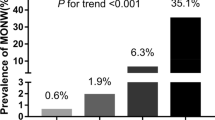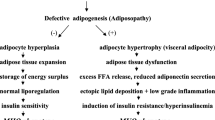Abstract
We aim to investigate the association between elevated tumor necrosis factor-α (TNF-α), interleukin-6 (IL-6) and high sensitivity-C-reactive protein (hs-CRP) with type 2 diabetes mellitus (T2DM) in abdominal obesity (AO) women subjects. A total of 428 AO subjects (age 48.4 ± 10.2 years), and 107 non-AO women subjects (age 48.8 ± 11.8 years) were enrolled for the all biochemistry testing, inflammatory cytokines, fasting insulin and Homeostasis Model Assessment of insulin resistance (HOMA-IR). Body mass index, waist circumference (WC), blood pressure (BP), plasma glucose (Glu), triglyceride (TG), insulin, HOMA-IR and inflammatory cytokines were significantly higher and lower total antioxidant capacity, HDL-C in AO subjects (p < 0.05). WC was significantly correlated with BP, Glu, TG, LDL-C, insulin, HOMA-IR, TNF-α, IL-6 and negative correlation with HDL-C in AO subjects. Elevation of TNF-α, IL-6, hs-CRP and insulin resistance were significantly associated with T2DM in AO subjects, after adjusting with insulin resistance, increased oxidative stress, elevated TG and reduced HDL-C by using multiple logistic regression analysis. In conclusions, elevation of inflammatory cytokines, oxidative stress and insulin resistance were associated with T2DM in AO women subjects. These inflammatory cytokines are positively associated with T2DM and may have a causal relation with an increased oxidative stress and insulin resistance in these AO women subjects.
Similar content being viewed by others
References
Yusuf S, Hawken S, Ounpuu S, Dans T, Avezum A, Lanas F, et al. Effect of potentially modifiable risk factors associated with myocardial infarction in 52 countries (the INTERHEART study): case-control study. Lancet. 2004;364:937–52.
deFerranti S, Mozaffarian D. The perfect storm: obesity, adipocyte dysfunction, and metabolic consequences. Clin Chem. 2008;54:945–55.
Tilg H, Moschen AR. Inflammatory mechanisms in the regulation of insulin resistance. Mol Med. 2008;14:222–31.
Festa A, D’Agostino R Jr, Howard G, Mykkanen L, Tracy RP, Haffner SM. Chronic subclinical inflammation as part of the insulin resistance syndrome: the insulin resistance atherosclerosis study (IRAS). Circulation. 2000;102:42–7.
Wu T, Dorn JP, Donahue RP, Sempos CT, Trevisan M. Associations of serum C-reactive protein with fasting insulin, glucose, and glycosylated hemoglobin: the third national health and nutrition examination Survey, 1988–1994. Am J Epidemiol. 2002;155:65–71.
Herder C, Schneitler S, Rathmann W, Haastert B, Schneitler H, Winkler H, et al. Low-grade inflammation, obesity, and insulin resistance in adolescents. J Clin Endocrinol Metab. 2007;92:4569–74.
Moran A, Steffen LM, Jacobs DR Jr, Steinberger J, Pankow JS, Hong CP, et al. Relation of C-reactive protein to insulin resistance and cardiovascular risk factors in youth. Diabetes Care. 2005;28:1763–8.
Lloyd LJ, Langley-Evans SC, McMullen S. Childhood obesity and adult cardiovascular disease risk: a systematic review. Int J Obes (Lond). 2010;34:18–28.
Whitaker RC, Wright JA, Pepe MS, Seidel KD, Dietz WH. Predicting obesity in young adulthood from childhood and parental obesity. N Engl J Med. 1997;337:869–73.
Fatani S, Pickavance LC, Sadler CJ, Harrold JA, Cassidy R, Wilding JP, et al. Differential vascular dysfunction in response to diets of differing macronutrient composition: a phenomenonological study. Nutr Metab (Lond). 2007;4:15–20.
Alberti KG, Zimmet P, Shaw J. Metabolic syndrome-a new world-wide definition. A consensus statement from the International Diabetes Federation. Diabet Med. 2006;23:469–80.
Joint National Committee. The sixth report of the Joint National Committee on prevention, detection, evaluation, and treatment of high blood pressure. Arch Intern Med. 1997;157:2413–46.
World Health Organization-International Society of Hypertension. World Health Organization-International Society of hypertension guidelines for the management of hypertension. Guidelines Subcommittee. J Hypertens. 1999;1999(17):151–83.
Matthews DR, Hosker JP, Rudenski AS, Naylor BA, Treacher DF, Turner RC. Homeostasis model assessment: insulin resistance and beta-cell function from fasting plasma glucose and insulin concentrations in man. Diabetologia. 1985;28:412–9.
Haffner SM, Kennedy E, Gonzalez C, Stern MP, Miettinen H. A prospective analysis of the HOMA model. The Mexico City Diabetes Study. Diabetes Care. 1996;19:1138–41.
Duncan MH, Singh BM, Wise PH, Carter G, Alaghband-Zadeh J. A simple measure of insulin resistance. Lancet. 1995;346:120–1.
Tangvarasittichai S, Poonsub P, Tangvarasittichai O, Sirigulsatien V. Serum levels of malondialdehyde in type 2 diabetes mellitus Thai subjects. Siriraj Med J. 2009;61:20–3.
Miller NJ, Rice-Evans C, Davies MJ, Gopinathan V, Milner A. A novel method for measuring antioxidant capacity and its application to monitoring the antioxidant status in premature neonates. Clin Sci (Lond). 1993;84:407–12.
Grundy SM, Cleeman JI, Daniels SR, Donato KA, Eckel RH, Franklin BA, et al. Diagnosis and management of the metabolic syndrome: an American Heart Association/National Heart, Lung, and Blood Institute Scientific Statement. Circulation. 2005;112:2735–52.
Laaksonen DE, Niskanen L, Nyyssönen K, Punnonen K, Tuomainen TP, Valkonen VP, et al. C-reactive protein and the development of the metabolic syndrome and diabetes in middle-aged men. Diabetologia. 2004;47:1403–10.
Niskanen L, Laaksonen DE, Nyyssönen K, Punnonen K, Valkonen VP, Fuentes R, et al. Inflammation, abdominal obesity, and smoking as predictors of hypertension. Hypertension. 2004;44:859–65.
Dvoráková-Lorenzová A, Suchánek P, Havel PJ, Stavek P, Karasova L, Valenta Z, et al. The decrease in C-reactive protein concentration after diet and physical activity induced weight reduction is associated with changes in plasma lipids, but not interleukin-6 or adiponectin. Metabolism. 2006;55:359–65.
Cai H, Harrison DG. Endothelial dysfunction in cardiovascular diseases: the role of oxidant stress. Circ Res. 2000;87:840–4.
Morrell CN. Reactive oxygen species: finding the right balance. Circ Res. 2008;103:571–2.
Wood LG, Gibson PG, Garg ML. A review of the methodology for assessing in vivo antioxidant capacity. J Sci Food Agric. 2006;86:2057–66.
Fernandez-Real JM, Ricart W. Insulin resistance and chronic cardiovascular inflammatory syndrome. Endrocrine Rev. 2002;24:278–301.
Schmidt MI, Duncan BB, Sharrett AR, Lindberg G, Savage PJ, Offenbacher S, et al. Markers of inflammation and prediction of diabetes mellitus in adults (Atherosclerosis Risk in Communities study): a cohort study. Lancet. 1999;353:1649–52.
Pi-Sunyer FX. The relation of adipose tissue to cardiometabolic risk. Clin Cornerstone. 2006;8(Suppl 4):S14–23.
Moller DE. Potential role TNF-α in the pathogengsis of insulin resistance and type 2 diabetes trends. Endocrinal Metab. 2000;11:212–7.
Hotamisligil GS, Budavari A, Murray D, Spiegelman BM. Reduced tyrosine kinase activity of the insulin receptor in obesity-diabetes. Central role of tumor necrosis factor-alpha. J Clin Invest. 1994;94:1543–9.
Patton JS, Shepard HM, Wilking H, Lewis G, Aggarwal BB, Eessalu TE, et al. Interferons and tumor necrosis factors have similar catabolic effects on 3T3-L1 cells. Proc Natl Acad Sci USA. 1986;83:8313–7.
Boden G. Role of fatty acids in the pathogenesis of insulin resistance and NIDDM. Diabetes. 1997;46:3–10.
Crichton MB, Nichols JE, Zhao Y, Bulun SE, Simpson ER. Expression of transcripts of interleukin-6 and related cytokines by human breast tumors, breast cancer cells, and adipose stromal cells. Mol Cell Endocrinol. 1996;118:215–20.
Fried SK, Bunkin DA, Greenberg AS. Omental and subcutaneous adipose tissues of obese subjects release interleukin-6: depot difference and regulation by glucocorticoid. J Clin Endocrinol Metab. 1998;83:847–50.
Feingold KR, Doerrler W, Dinarello CA, Fiers W, Grunfeld C. Stimulation of lipolysis in cultured fat cells by tumor necrosis factor, interleukin-1, and the interferons is blocked by inhibition of prostaglandin synthesis. Endocrinology. 1992;130:10–6.
Greenberg AS, Nordan RP, McIntosh J, Calvo JC, Scow RO, Jablons D. Interleukin 6 reduces lipoprotein lipase activity in adipose tissue of mice in vivo and in 3T3-L1 adipocytes: a possible role for interleukin 6 in cancer cachexia. Cancer Res. 1992;52:4113–6.
Mohamed-Ali V, Goodrick S, Rawesh A, Katz DR, Miles JM, Yudkin JS, et al. Subcutaneous adipose tissue releases interleukin-6, but not tumor necrosis factor-α, in vivo. J Clin Endocrinol Metab. 1997;82:4196–200.
Cardellini M, Andreozzi F, Laratta E, Marini MA, Lauro R, Hribal ML, et al. Plasma IL-6 levels are increased in subjects with impaired glucose tolerance but not in those with impaired fasting glucose in a cohort of Italian caucasians. Diabetes Metab Res. 2007;23(2):141–5.
Gupta A, Ten S, Anhalt H. Serum levels of soluble TNF-α receptor 2 are linked to insulin resistance and glucose tolerance in children. Pediatric Endocrinol Metab. 2005;18:75–82.
Choi KM, Lee J, Lee KW, Seo JA, Oh JH, Kim SG, et al. Comparison of serum concentrations of C-reactive protein, TNF-α and IL-6 between elderly Korean women with normal and impaired glucose tolerance. Diabetes Res Clin Pract. 2004;64:99–106.
Hotamisligil GS, Spiegelman BM. Tumor necrosis factor-a: a key component of the obesity-diabetes link. Diabetes. 1994;43:1271–8.
Acknowledgments
We sincerely thank Naresuan University and National Health Security Office (NHSO), Region 3′s Blog (Nakornsawan) for financial support and all co-workers of the Sai-Ngam Health Promotion Hospitals for their blood collection and technical assistance. We especially thank those who participated and donated blood samples for this study. Finally we sincerely thank Asst. Prof. Dr. Ronald A. Markwardt for his critical reading and correcting of the manuscript.
Author information
Authors and Affiliations
Corresponding author
Rights and permissions
About this article
Cite this article
Tangvarasittichai, S., Pongthaisong, S. & Tangvarasittichai, O. Tumor Necrosis Factor-Α, Interleukin-6, C-Reactive Protein Levels and Insulin Resistance Associated with Type 2 Diabetes in Abdominal Obesity Women. Ind J Clin Biochem 31, 68–74 (2016). https://doi.org/10.1007/s12291-015-0514-0
Received:
Accepted:
Published:
Issue Date:
DOI: https://doi.org/10.1007/s12291-015-0514-0




